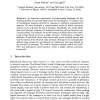383 search results - page 31 / 77 » Stable concurrent synchronization in dynamic system networks |
RECOMB
2005
Springer
14 years 8 months ago
2005
Springer
Background: Most cellular processes are carried out by multi-protein complexes, groups of proteins that bind together to perform a specific task. Some proteins form stable complex...
EMSOFT
2007
Springer
13 years 11 months ago
2007
Springer
Synchronous reactive formalisms associate concurrent behaviors to precise schedules on global clock(s). This allows a non-ambiguous notion of "absent" signal, which can ...
JUCS
2008
13 years 7 months ago
2008
: Multi-Agent Systems (MAS) constitute a well known approach in modelling dynamical real world systems. Recently, this technology has been applied to Wireless Communication Systems...
ECOOPW
1994
Springer
13 years 11 months ago
1994
Springer
ing Interactions Based on Message Sets Svend Frr 1 and Gul Agha2. 1 Hewlett-Packard Laboratories, 1501 Page Mill Road, Palo Alto, CA 94303 2 University of Illinois, 1304 W. Springf...
ICDCS
2005
IEEE
14 years 1 months ago
2005
IEEE
The group mutual exclusion problem extends the traditional mutual exclusion problem by associating a type with each critical section. In this problem, processes requesting critica...

